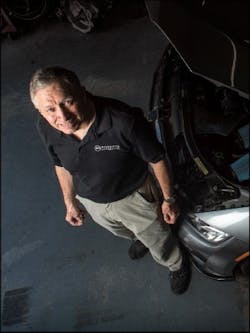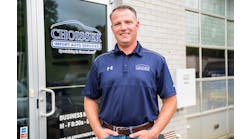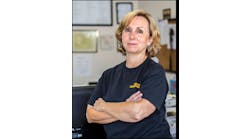All he did was put up a flag—a simple, standard-sized American flag.
The idea seemed so basic, too basic to actually be effective, but P.J. Roberts thought he’d give it a try. After all, Roberts Automotive had sat on Columbia Avenue in Mountville, Pa., for more than 35 years, and Roberts still heard the same thing, again and again.
“We’re on a fairly busy highway; we get 20,000 cars a day that go by,” Roberts says. “But I had people all the time say, ‘Hey, I’ve been driving by for years and didn’t know you were here.’”
So, he put up a flag, attaching it to a post of the shop’s roadside sign. That sign—roughly 5 feet by 8 feet and another 8 feet or so off the ground—had been there for years; only now, post-flag, customers asked about it as if it were brand new.
“Don’t assume they know you, don’t assume anything,” Roberts says. “We can’t just sit back and trust that people are coming into the shop because it’s what’s best for them, and we can’t assume that they know where to go.
“Just putting up a flag—it’s the simplest thing, and it had a huge effect on our visibility with customers.”
While it’s certainly far from being Roberts’ most sophisticated marketing solution, William Johnson of Automated Marketing Group (AMG) says that scenarios like this one highlight the entire concept of marketing.
“Marketing is about letting people know you’re there, letting people see you, see who you are and see what you stand for,” Johnson says. “It can be as simple as that.”
The automotive repair industry has become more complex, running a service business has become increasingly more difficult, and marketing—a long over-looked aspect of shop management—has become absolutely critical to a business’s success.
So, what’s the secret to effective marketing? That’s the question Johnson gets from hundreds of shop owners and clients across the country. And it’s simple, really; whether you run a small-town, family-owned shop like Roberts or you’re at the helm of a growing multi-location company, like Doug Grills in Maryland, marketing is about understanding your customers, connecting with them, and building a long-term relationship.
Operators like Roberts and Grills have figured it out—and it’s something they say every shop can, and must, do. It’s time to put up your flag.
Modern Marketing:
Doug Grills’ Sophisticated System to Attracting and Retaining Customers
Doug Grills remembers a time when, if someone had asked him how his latest marketing strategy was going, he’d have to check his car count, or maybe total sales, or maybe he’d just shrug.
“We used to focus on full-page ads in the Yellow Pages, and mailers, AAA membership, word-of-mouth referrals,” he says. “It’s just what everyone did, and you’d look at your bays, see they’re full, and assume it was all going well.”
Grills and his business partner, Rick Levitan, opened their first gas-station-style service center in 1999. They opened a second in 2001, and by August, the two will have four facilities, each having shifted its focus to full-service repair and maintenance work.
The two opened AutoStream Car Care Center in Ellicott City, Md., just as the Internet and online search took off. Since that time, small business marketing has changed dramatically, and Grills and AutoStream were early adapters to all things digital.
Today, some 15 years later, if Grills is asked about the success of a particular marketing campaign, he does what any sensible person in the modern, mobile age does when seeking the answer to a question: He pulls out his smartphone.
“It’s all right there: every number, every metric to track all of our campaigns from adwords to SEO to social media,” he says. “We have our number of leads, our number of converted sales, sales in dollars, total ROs, everything.”
This is marketing at its most sophisticated. This is marketing’s future, Grills says.
High-Speed, Real-Time Marketing
As Grills scrolls through the dashboard-style display on his phone, the Autoshop Autobahn program shows simple gauges, each labeled correspondingly: “Additional Revenue,” “Web Visits,” “New Customers,” etc.
Grills was the first shop owner in the country to receive the beta version of Autoshop Solutions’ latest product. AutoStream Car Care was the guinea pig for the brand-new platform that the industry marketing company hopes will revolutionize the way shops track their various initiatives.
It’s not about a program, though, Grills says. It’s about information. Modern marketing must rely on metrics and analysis to be effective, and Grills doesn’t want to see his dollars go to waste. The Autobahn is the tool he uses today for this information, but remember, he says, no tool or piece of equipment makes up for a lack of understanding.
The Autobahn is an Internet-based program, which users can log into through their web browsers. The program becomes mobile through the website’s responsive design, making it just as accessible on a tablet or phone as it is on a desktop. Through advanced algorithms, the Autobahn provides detailed reports, updated in real time, that can precisely tell a shop operator how many customers his or her Google AdWords campaign has yielded over a given period of time, for example; or it could give an exact number as to the dollars received through Facebook. It can even track direct mail ROI. There are myriad other features, like being able to upload photos or text to add to a shop’s website or social media page and a communication tool for contacting the Autoshop Solutions team. Overall, though, the simplest way to think of the program, Grills says, is that it gives a real-time pulse of all your marketing efforts.
“That’s what we’re all looking for: real answers to the return we’re getting on our marketing,” Grills says. “We don’t do Internet marketing or focus on SEO because it’s trendy; we do it because it works. [The Autobahn] allows us to see what is working at each location and each market, and helps us better understand where to make investments.”
The New Word of Mouth
Grills is quick to point out that simply having the results at your disposal doesn’t automatically lead to marketing success. Of course, his shop must utilize effective campaigns that take into account the habits of his mostly urban customers.
His goal is to provide a consistent representation of his company across all platforms of his marketing. That’s the only way to demonstrate to customers what his business is all about—who they are, what they stand for, why customers can count on them.
“It’s really no different than back when we started in that it’s still about reputation and word of mouth and referrals,” Grills says. “It’s just that your reputation lives online now.”
Consumers look to the Internet first for information, Grills explains, and he needs his business to be represented. He has a search-engine-optimized website—one that hits on key search words for each of his soon-to-be four markets. His site has a responsive design, which not only helps viewability on mobile devices but improves its ranking in Google.
He also does pay-per-click campaigns through Google AdWords that attach his ad to specific search words in each market. (For instance, his Columbia, Md., market had an influx of searches for brake jobs one month, and he shifted his campaign to advertise whenever someone searched for brake work.)
Online reviews are just as important, and Grills focuses on keeping all of his company’s ancillary sites—Facebook, Yelp!, Google+, Angie’s List, etc.—consistent and up-to-date. Each needs to have the same message, theme and feel, he says. And he personally interacts with customers on each site. It’s a large reason the shop has more than 700 reviews across all platforms, the majority of which are five stars.
“This is where customers are now; this is our Yellow Pages today, this is our word of mouth,” he says.
Grills’ annual marketing budget is roughly 8 percent of his total bay sales; that’s just over $200,000 each year. Some of that is spent on sales aids and collateral materials in the shops (such as invoices, seat covers, mirror hangers, etc.), and he does direct mail through Moving Targets to new residents in each market (“Direct mail is still very, very effective,” Grills says). But, more than half of his marketing budget goes to digital efforts.
The heavy marketing investment has helped the company grow each year and earn market share in a competitive market. With the addition of the fourth facility this year, Grills pictures AutoStream as a $4 million company in the near future.
“This has never been a business where your gut can drive it,” he says. “You need real data to make decisions with. Just because something works in one location, doesn’t mean it will work in another. You need to check, you need to analyze and you need to adapt.”
Keep It Simple:
P.J. Roberts’ Dedication to Connecting with Customers
Of course, Roberts Automotive has pens. Roberts buys them in bulk: $250 for 500, each labeled with the Roberts Automotive logo and phone number.
“Think about how people always accidentally sign for a check at a restaurant or a receipt at a store and take the pen with them,” Roberts explains. “We do the opposite, our staff brings these pens with them, and we use them and leave them at various businesses.
“I was out to dinner the other week, and the bill comes, and one of our pens was in the book.”
Let’s step back for a moment. Don’t confuse Roberts’ old-school marketing tactic for a lack of understanding of modern consumers; in fact, it’s just the opposite. Sure, Roberts has an optimized website, focused on SEO results. (He even writes a regular blog on it to increase its search rankings.) His business is current and consistent across social platforms, and he uses email campaigns through Demandforce to stay connected with those in his database.
“But you can’t ignore results, and you can’t ignore numbers and what’s working,” Roberts says. “We know where the majority of our customers come from, and we focus our dollars on what works best for us.
“That’s the lesson for anyone: Use what works for you. Every market is different. Every shop is different. Find your best strategy.”
Surveying the Situation
Roberts calls his market “static,” just as many around the country are. Lancaster County isn’t growing rapidly. His shop isn’t getting a dramatic influx of new potential customers anytime soon.
“We have lots of shops that have been around a long time, and we have the same amount of customers [in the total market],” he explains. “It gets down to shops stealing customers from each other. And, let’s be honest, whoever does the best marketing wins.”
Roberts opened the shop with his father in the 1980s, a two-man business that stayed stable, if not a bit stagnant, over the next two decades, reaching roughly $360,000 in total sales by 2000. That’s when he noticed the industry beginning to change: Cars were built better, customers were coming in less frequently, and if Roberts Automotive was to survive, he needed to focus on capturing his county’s limited market share.
That’s when he joined a 20 Group, and began putting money into marketing—something he’d never done in the past.
Not one to blindly throw money at a problem, Roberts wanted a tangible way to measure his marketing investments.
“We figured that the easiest way to find out what was working was to ask,” he says.
He developed surveys in numerous forms. There’s a simple, one-question version given verbally from service advisors (“How’d you hear about us?”), and there is a more comprehensive version that customers can fill out after the repair, detailing not only how they heard of the shop but also where they live, their search habits, their feelings about direct mail pieces, the importance of discounts (or lack thereof), what they look for in a shop, what they look for in an advertisement, etc.
“It’s actually remarkable how many people willingly help out with this,” he says. “The vast majority of our customers will fill it out, and it gives us the information we need to move ahead.”
The Marketing Iceberg
“The big tendency for people is to focus on activity, because a lot of times, that’s the only thing they know how to measure,” says William Johnson of Automated Marketing Group (AMG). “But not every click in AdWords means a new customers. Not all activity means money for your shop.”
Johnson says to think of the way most track marketing as an iceberg: Activity metrics—number of responses, number of customers brought in, number of sales, basic ROI—are all just the tip rising above the water.
“You can get what appears to be a solid return—a certain amount of customers for a certain amount of dollars spent on a campaign—and that campaign could still be killing your shop,” he says.
Results come with getting the right customers for your business, ones that come back and ones that spend money based on your recommendations. That’s the only way to truly grow your business through marketing, Johnson says.
Better metrics to measure would be attrition rate, visits per year, ARO and overall car count, Johnson says. Those numbers demonstrate the level of customer you have and whether they stay loyal to your business.
Finding the Answers
Roughly 70 percent of Roberts Automotive’s new customers come from the website and online search. The rest come from a mixture of direct mail and referrals—two initiatives Roberts takes a unique approach to.
He uses a local printer for his direct mail initiatives, and they focus on out-of-the-box ideas: a special for National Dog Day, or a “Procrastination Special” with the offer not expiring for several months.
“We do a lot of the designs and things ourselves, just keeping it simple,” he says. “We used to spend a lot of money on a company to make these super slick ones for us, and we found that customers didn’t like it as much.
“In our area, people want to do business with someone that’s local and has that local feel. We focus everything on delivering that.”
That’s why Roberts works diligently to build his referral network. He hands out two referral cards to customers when they pick up their vehicles. The new customer turns in the card and gets $15 off the first repair; the person who referred them gets a gift card.
“We get six to seven of those returned every week,” Roberts says.
It’s simple, he says, very simple, and other shops shouldn’t overlook ideas just because they seem old-school or too basic.
“You do what reaches your customers,” he says. “I know a shop in Denver that does no paper marketing. We can’t get away with that here. We know our customers, we know what they want and we try to reach them in the way they want. If that changes, we’ll adjust, too.”



